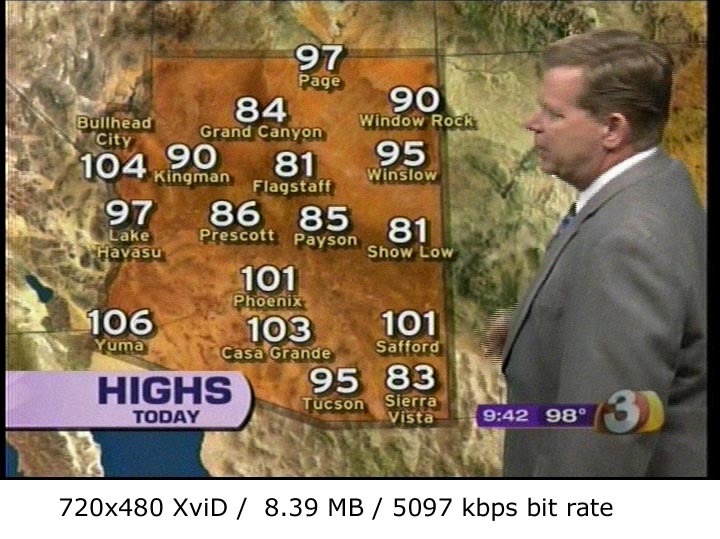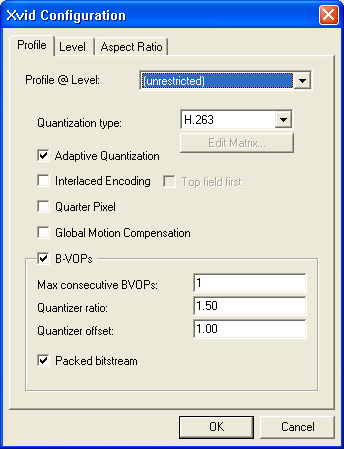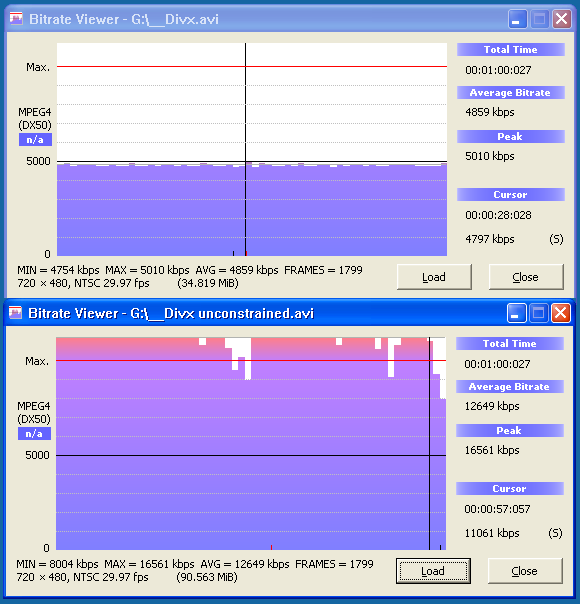I am hoping someone can offer some suggestion/Opinion for compressing home movies. I have about 150 Home Movie clips that I have captured from OLD VHS tapes and my newer MiniDV camera. I would like to compress these clips for archiving but I am unsure which compression to use.
As a Test I took the same clip (2:17 in length) and compressed it 3 different ways.
1. With Xvid single pass default setting, the file was 38.2 MB
2. With Xvix 2 pass the file was 168 MB (I did first pass then second pass)
3. DivX 6.8.5 using the Home theater profile preset 5, 1 pass the file was 54 MB
What i am trying to figure out is what compression should i use for arching and later watching these videos with the possibility to burn them to DVDs later. I know that uncompressed will give me the best quality, but the major trade off is the video size.
Can someone suggestion a compression for decent quality and decent file size?
Should I deinterlace the videos when I am doing the compression?
For all the tests I used the LAME audio compression for the sound.
Someone please help....as I watch these videos I really cant tell much of a difference in the quality on my monitor but I dont know if the quality will change when I try to watch them on my TV.
Which brings up another point. Most of the time when I want to watch the clips, I use a computer hooked up to a TV set with Windows Media Center and watch the clips, I did this so I don't need to burn movies etc when I want to watch them on TV...I just use a the computer that is dedicated to the TV and watch them through my wired network.
Once I figure out the best method I will create a VDub setting file so I can always use the same settings when compressing the videos
+ Reply to Thread
Results 1 to 26 of 26
-
-
Just burn them to a DVD right now instead...why ruin them? Learn how to frameserve the clips over to something like TMPGEnc Plus...straight from VDub to mpeg2/DVD quality.
-
What format are your captured VHS clips?
I assume the MiniDV source are still DV format?
If you want to re-edit in the future or play with highest quality I suggest you do not deinterlace*. HDD capacity is cheap. I keep my VHS clips as interlace MPeg2 and DV as DV.
For playback convenience I have encoded my DV material to interlace MPeg2 for DVD.
Currently h.264 has poor interlace performance and VC-1 requires bit rates close to DV. When this situation improves, I'll consider these formats instead of MPeg2. As hard drives get cheaper, I see little reason to convert.
*Home camcorder material has lots of shake, pan and zoom that makes deinterlace and compression highly lossy. Newer TV sets handle interlace properly even converting 60 fields per second to 120 frames per second for display.Recommends: Kiva.org - Loans that change lives.
http://www.kiva.org/about -
hech54, I primarily watch the movies on computers instead of DVD players. My Home network has 8 computers....two of these computers are hooked up directly to TV sets. When I want to watch home movies I switch the TVs to the computer input and watch the home movies with Windows XP Media Center Edition, it works nice because the computers have the media center remote and the home movies are stored on a network hard drive. THis is great because I do not have to burn DVD to watch home movies or other movies that I download. So instead of burning I would rather have the avi files.
edDV, to be honest the captured VHS tapes are not a big concern. They where converted using a stand alone DVD burner to DVDs then ripped using Magic DVD ripper. The file sizes are reasonable.
I guess my main question is once I capture from my DVD camera (using the firewire cable) what compression is suggested for the miniDV movies. I noticed that Xvid makes smaller files, but am I losing quality if I choose Xvid over DivX? -
Xvid, single pass, target quantizer defaults to a quantizer of 4. For "watchable" video I would use 3. The video turns out whatever size is necessary to deliver the requested quality (1/quantizer).
With Xvid, 2-pass, the file size will be determined by the selected bitrate. I think the default is 700 kbps. Too low a bitrate and the video gets all blocky. Too high a bitrate and the file gets too big.
Divx's 1 pass "quality based" encoding is similar to Xvid's target quantizer encoding. Constant quality by the selected Quantizer. In my experience, Divx generates larger files at the same quantizer value.
Keep in mind Xvid remembers all its settings from session to session. So if you changed any of the settings since installing it they won't be at their defaults. Press the Load Defaults button to restore everything to their default values.
I wouldn't convert to Xvid or Divx and then later convert to MPEG for DVD. Go straight to MPEG for DVD from your source. -
jagabo, thanks so much your answer helped me a lot....i think I will use Xvid loading the defaults and a setting of 3 for encoding the video to watch on my home network.
If I later decide to burn to DVD (i doubt that I will need to unless i want to make a copy for family members) I will re-capture the miniDV tape and burn from the source. -
I only use a quantizer of 2 on both DivX and XviD for files that I'll view on TV.
DivX file size is slightly larger than XviD (not much these days) but encodes way faster than XviD so if you're doing a lot of conversions, you might consider DivX 6.8, Home Theater Profile, 1-Pass Quality-Based with a Target Quantizer of 2.
A Quantizer of 3 doesn't look too bad on a PC monitor but watching on a TV you'll see a noticable loss in quality. -
I did a little more experimenting. I took a 30 sec clip and compressed it several ways. Then I too the same frame from each clip and compared them for quality. I used this frame because there was something very close to the camera and something very far away. Based on the pictures I found that XVid produces a better quality even though it's slower. The filesize diference between XVid 3 and Xvid 4 was about 10 MB for a 30 second clip. DivX definately seems more blotchy to me. Even DivX preset 10 (best quality) looks worse then Xvid 3 and 4. And just for fun I did Xvid 31..wow that is horrible LOL
DivX Home Theater Profile Preset 2

DivX Home Theater Profile Preset 3

DivX Home Theater Profile Preset 4

DivX Home Theater Profile Preset 10

XVid Preset 1

XVid Preset 3

XVid Preset 4

XVid Preset 31

-
You need to change the quantizer in Divx, not the Preset. When using Divx in quality based mode the Quantizer determines the picture quality. The Preset determines how hard the encoder works to get more compresssion. Ultimately, the higher the preset the smaller the file -- for a given quantizer. Presets above 6 are pretty much useless. They take longer to encode but make very little difference in the final file size.
In Xvid you are changing the Quantizer, not the Preset. And the effects are the same: The Quantizer controls quality, Preset controls file size for a given quantizer. -
Now encode with the DivX codec and use the settings that I described. Nobody said anything about using presets. Of coarse XviD is going to look better at a Quantizer of 2 compared to a DivX preset. If you're not going to use a quantizer of 2 with DivX then up the bitrate to match the XviD instead of default 780kbps.

-
OK....I didnt know the difference between Quantizer and preset. I did what was posted in the screen shot for DivX and used these settings for XVid

Xvid Still Looks better...but the file size is much larger for Xvid...
XVid 51.8 MB
DivX 18.3 MB.
I am trying to compare "Apples to Apples" so I can decide which is better to use. Am i doing this correctly now?
Here are the 2 new images
DivX Quantizer 2

XVid Quzntizer 2 (Settings from screen shot)

Thanks for everyone's help -
Something is still definately wrong. The DivX file size should be bigger than the XviD file and shouldn't look like that. It looks exactly like the first pic that you showed with the DivX default settings. I assume 780kbps. Use MediaInfo and see what the bitrate is. The DivX file should have a higher bitrate than the XviD file with a quantizer of 2.
-
I just did a TV capture and converted to XviD and DivX using a Quantizer of 2 and here is what I got.


-
Does your version of Xvid have the Adaptive Quanization option on the Profile @ Level -> More dialog?

If not, you should get one that does and use the feature.
I know you're using a PC, but keep in mind that playback of Divx/Xvid encodes at high bitrates (like you get with quantizer 2) can be problematic on some standalone players. -
I'm using Adaptive Quantization.
My Philips 5990 plays the files OK although it has trouble playing large high bitrate files from the thumbdrive. Not really a problem playing, just takes a long time to load the files. Once they load, they play fine.
I use my WDTV media player for playing video files on my TV so the high bitrates aren't a problem. That's the main reason that I bought it. So I could play HD clips that I could not play on a DVD player.
I hardly ever use the DVD player anymore. -
DarrellS, I used Media Info and here are the results
I re-encoded a 30 second clip from the original source. Since we are not talking about the audio I left it at direct stream copy for all the encodings.
I used DivX, clicked "Restore defaults" Used Home Theater Profile , unchecked Encoder presets, Rate control mode set to 1-pass quality-based, Target quantizer 2.
MediaInfo says this

I used XVid, clicked Load Defaults, changed Target quantizer to 2, unrestricted profile, Single Pass and got this in MediaInfo

I used XVid, clicked Load Defaults, changed Target quantizer to 2, unrestricted profile > clicked More and checked Adaptive Quantization > Single Pass and got this in Media Info

I can see the difference in the Bitrates now. But not sure what to do. I have read that the bitrate determines the size of the file. But I want all the videos to have the same quality. Obviously I want the size small as possible while still having a "watchable" quality.
Can you suggest setting in DivX or Xvid to get this result? -
In Divx the Home Theater profile caps the bitrate, even in constant quality mode. Xvid doesn't. That is why the Xvid file has a much higher bitrate compared to Divx. Use Divx's Unconstrained profile if you want true constant quality output from it.
Open your videos with Bitrate Viewer. It will show you a graph of bitrate over time. I think you'll see the bitrate of the Divx file is pegged at 5 Mbps for the whole video. The Xvid file will have a 14 Mbps average with even higher peaks.
Bitrate Viewer display of Divx (from DV AVI) at quantizer 2. The top is with Home Theater profile, the bottom is with the same settings except Unconstrained:

-
So this is why the quality of the Xvid look much better then the DivX...If I change the profile of DivX to Unconstrained I be able to truly compare Xvid and DivX to see which one suits me better?
-
Ok It looks like i am finally comparing apples to apples. It still looks like Xvid is the way to go for me. It produces a very similar quality video at a smaller filesize
I used in Unconstrained profile in DivX Quantizier 2 and Got this
MediaInfo: 17.3 Mbps 720*480 at 29.970 Fps
Filesize: 10.9 MB for a 5 second clip

I used in Unconstrained profile in Xvid Quantizier 2 and Got this
MediaInfo: 11.8 Mbps 720*480 at 29.970 Fps
Filesize: 7.66 MB for a 5 second clip

-
That sounds about right. The file size will vary depending on the video being compressed but the quality will always be the same.Originally Posted by quxote
-
Thanks everyone for the help...I learned more in this thread that I thought I would, and now I know which compression to use and what a quantizer means. Now comes the job of re-tranferring all my miniDV clips because I was always using the DivX preset 10 setting with Home theater profile and it looks like that was not be best way to do it.
I guess it would not be suggested to re-compress the DivX clips to Xvid because it will worsen the quality correct? -
Yes, go back to your sources. Don't recompress Divx to Xvid. Doing so would further decrease the quality.
-
I did some testing and it looks like DivX unconstrained with a Quantizer of 3 is almost identical to XviD unconstrained with a quantizer of 2.
General
Complete name : C:\Documents and Settings\Darrell\Desktop\20090724_214216.avi
Format : AVI
Format/Info : Audio Video Interleave
File size : 9.03 MiB
Duration : 13s 780ms
Overall bit rate : 5 494 Kbps
Writing library : VirtualDub build 32507/release
Video
Format : MPEG-4 Visual
Format settings, BVOP : No
Format settings, QPel : No
Format settings, GMC : No warppoints
Format settings, Matrix : Default
Codec ID : DX50
Codec ID/Hint : DivX 5
Duration : 13s 780ms
Bit rate : 5 484 Kbps
Width : 720 pixels
Height : 480 pixels
Display aspect ratio : 1.500
Frame rate : 29.970 fps
Standard : NTSC
Resolution : 24 bits
Colorimetry : 4:2:0
Scan type : Progressive
Bits/(Pixel*Frame) : 0.529
Stream size : 9.01 MiB (100%)
Writing library : DivX 2816
General
Complete name : C:\Documents and Settings\Darrell\Desktop\20090724_214217.avi
Format : AVI
Format/Info : Audio Video Interleave
File size : 9.35 MiB
Duration : 13s 780ms
Overall bit rate : 5 689 Kbps
Writing library : VirtualDub build 32507/release
Video
Format : MPEG-4 Visual
Format profile : Streaming Video@L1
Format settings, BVOP : Yes
Format settings, QPel : No
Format settings, GMC : No warppoints
Format settings, Matrix : Default
Muxing mode : Packed bitstream
Codec ID : XVID
Codec ID/Hint : XviD
Duration : 13s 780ms
Bit rate : 5 678 Kbps
Width : 720 pixels
Height : 480 pixels
Display aspect ratio : 1.500
Frame rate : 29.970 fps
Standard : NTSC
Resolution : 24 bits
Colorimetry : 4:2:0
Scan type : Progressive
Bits/(Pixel*Frame) : 0.548
Stream size : 9.33 MiB (100%)
Writing library : XviD 1.2.1 (UTC 2008-12-04)
Looks like I might start using DivX in unconstrained mode with a quantizer of 3 instead of Home Theater with a quantizer of 2.. -
The file sizes may be the same but Xvid at Q=2 is better quality than Divx at Q=3. Look at enlarged still frames -- especially in dark areas.
-
I knew that Q3 in Home Theater mode looked bad, especially in the dark areas like you mentioned but since they both have practically the same bitrate in unconstrained mode, I assumed they would have the same quality. I'll have to experiment.
I think my converting to DivX/Xvid days may be about over though. My friend has Videoredo TV Suite and it works beautifully for my Hauppauge HVR 1800 TV captures. I think I'll be purchasing it to cut out all the commercials and keep the files as MPEG2. This way, I lose no quality and all my files stay in sync. Converting to AVI is hit or miss with the audio and usually miss, especially with football games over three hours. -
I was going to mention earlier that with Xvid a quantizer 2 the files will be almost as big, or maybe even bigger, than your MPEG2 source. So you might as well leave them as MPEG 2.Originally Posted by DarrellS
Similar Threads
-
VirtualDub Compression Not Working
By jjis in forum EditingReplies: 3Last Post: 3rd Apr 2011, 10:14 -
different compression virtualdub
By chewie8008 in forum EditingReplies: 14Last Post: 8th Aug 2009, 13:45 -
Threaded Compression In VirtualDub
By Soopafresh in forum Latest Video NewsReplies: 14Last Post: 1st Feb 2009, 03:15 -
virtualdub compression for dx50?
By majax79 in forum EditingReplies: 4Last Post: 22nd Dec 2007, 22:51 -
Audio compression with VirtualDUb!
By kehn in forum AudioReplies: 5Last Post: 27th Jul 2007, 01:10




 Quote
Quote